Advanced Techniques in Steel Stamping for Accuracy Manufacturing
As markets continuously demand better tolerances and complex designs in their metal components, the pursuit for innovative techniques in steel marking has actually heightened. From the application of advanced multi-stage marking processes to the integration of innovative automation innovations, the landscape of metal stamping is undergoing a profound makeover.
Advanced Multi-Stage Stamping Procedures
Reviewing the ins and outs of sophisticated multi-stage marking processes exposes the innovative methods utilized in modern manufacturing techniques. Metal Stamping. Multi-stage stamping is a complicated process that entails multiple steps to change a level sheet of steel into a last stamped item. The usage of dynamic passes away, where various procedures are executed at each stage of the marking process, enables high precision and effectiveness in the manufacturing of detailed steel parts
During the preliminary phases of multi-stage stamping, the flat metal sheet is fed into the stamping press, where a collection of dies are made use of to reduce and form the product. Subsequent phases involve added forming, bending, and punching procedures to additional fine-tune the part. Each phase is meticulously designed to build on the previous one, bring about the creation of complicated geometries with limited resistances.
Advanced multi-stage stamping processes call for a high level of knowledge and precision to make sure the high quality and uniformity of the stamped parts. By utilizing advanced equipment and tooling, suppliers can generate a vast array of steel parts with efficiency and accuracy.
Accuracy Tooling Innovations
Accuracy tooling advancements have actually reinvented the metal marking industry, improving effectiveness and top quality in manufacturing processes. CNC systems permit for detailed layouts to be translated straight right into tooling, ensuring accuracy and repeatability in the stamping process.
Additionally, the assimilation of sensing units and real-time tracking abilities in accuracy tooling has allowed producers to find and deal with concerns promptly, decreasing downtime and minimizing scrap rates. By integrating wise innovation right into tooling, drivers can maximize criteria such as pressure, rate, and alignment during the stamping operation, leading to enhanced item quality and enhanced efficiency.

Automation in Steel Stamping
The development of precision tooling technologies in the metal marking sector has actually led the way for considerable innovations in automation, changing the manufacturing landscape in the direction of enhanced effectiveness and productivity. Metal Stamping. Automation in metal marking entails using innovative machinery and robotics to execute numerous tasks typically performed by human operators. This change in the direction of automation supplies countless benefits, consisting of boosted accuracy, much faster manufacturing cycles, and lowered labor original site expenses
One trick aspect of automation in metal marking is the implementation of computer mathematical control (CNC) systems, which allow exact control over the stamping procedure. CNC technology permits the development of complicated and complex steel get rid of consistent top quality. Additionally, automated systems can be programmed to run constantly, leading to greater output prices and shorter preparations.
In addition, automation boosts office safety by reducing hands-on handling of heavy materials and minimizing the risk of accidents (Metal Stamping). As making markets remain to accept automation, the future of metal marking holds great read this promise for even greater efficiency and innovation
High-Speed Stamping Methods

Among the main benefits of high-speed marking methods is the ability to create a large quantity of components in a shorter amount of time contrasted to conventional stamping approaches. This increased productivity not just allows suppliers to meet tight production target dates but also allows price savings through economic situations of scale. Furthermore, high-speed stamping can assist reduce product waste by maximizing the material use throughout the marking process.
In addition, high-speed stamping strategies commonly integrate ingenious attributes such as quick die adjustment systems and real-time tracking capabilities, further improving the total performance and flexibility of the steel marking process. As modern technology remains to advancement, high-speed marking is expected to play an essential duty in driving the future of precision manufacturing.
Quality Assurance in Stamping Operations
Reliable quality control measures are necessary see page for making sure the reliability and uniformity of metal marking procedures. Quality assurance in stamping procedures entails a collection of systematic procedures targeted at identifying and protecting against problems in the manufactured elements. One critical element of high quality control in metal stamping is making use of sophisticated inspection strategies such as optical evaluation systems and coordinate determining devices (CMMs) to verify the dimensions and resistances of stamped parts.
In addition, top quality control procedures in stamping operations commonly include the implementation of statistical procedure control (copyright) techniques to check the production procedure in real-time and ensure that it stays within appropriate limits. By analyzing information and identifying trends, suppliers can proactively resolve any kind of discrepancies from the preferred top quality requirements.
Moreover, high quality control in metal stamping operations additionally involves complete material screening to guarantee that the raw products used satisfy the needed requirements for the stamping procedure. This might include performing product hardness tests, tensile strength examinations, and dimensional examinations to guarantee the quality and stability of the stamped components. On the whole, executing robust quality assurance actions is vital for accomplishing top notch stamped parts continually.
Verdict
In verdict, advanced methods in steel marking play an important role in accuracy production processes. With multi-stage stamping processes, innovative tooling remedies, automation, high-speed strategies, and strenuous quality assurance steps, manufacturers can accomplish greater levels of accuracy and effectiveness in their operations. These advancements in steel marking modern technology have allowed companies to generate intricate components with tight tolerances, eventually causing boosted item high quality and customer satisfaction in the manufacturing sector.
Comments on “The Function of Metal Stamping in Modern Production and Product Advancement”